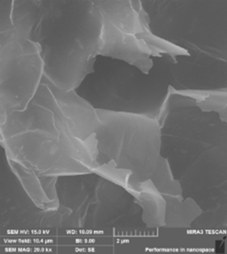Graphene NMP Dispersion, Purity: 99.5%, Graphene: 1,0 wt%
Graphene NMP Dispersion, Purity: 99.5%, Graphene: 1.0 wt% refers to a liquid suspension of graphene in N-Methyl-2-pyrrolidone (NMP), where graphene constitutes 1.0 weight percent of the total mixture.
Properties of Graphene NMP Dispersion:
- Stability:
- NMP ensures the graphene particles remain well-dispersed and stable, preventing clumping or settling over time.
- High Graphene Content:
- The 1.0 wt% concentration allows for more graphene to be deposited or incorporated into materials, making it suitable for applications requiring a higher graphene loading.
- Electrical Conductivity:
- The graphene in the dispersion retains its excellent electrical properties, making it ideal for conductive films, inks, and composites.
- Thermal Conductivity:
- The dispersion maintains graphene’s ability to conduct heat efficiently, making it useful for thermal management applications.
- Ease of Application:
- The liquid form allows for easy integration into manufacturing processes, such as coating, printing, or spraying.
Applications of Graphene NMP Dispersion (1.0 wt%):
- Electronics:
- Conductive Inks and Films: Used for printed electronics, flexible circuits, and touchscreens.
- Transparent Conductors: Applied to create thin, conductive coatings for displays or solar cells.
- Energy Storage:
- Batteries: Enhances the performance of electrodes in lithium-ion batteries by improving conductivity and cycle life.
- Supercapacitors: Improves energy density and charge/discharge rates.
- Coatings:
- Conductive Coatings: Provides anti-static and conductive properties for industrial and consumer applications.
- Thermal Coatings: Used in heat dissipation systems for electronics and machinery.
- Composite Materials:
- Enhances the mechanical, thermal, and electrical properties of polymers, ceramics, or other composite materials. Used in aerospace, automotive, and construction industries.
- Sensors:
- Gas Sensors: Detects gases with high sensitivity due to graphene’s large surface area and conductivity.
- Biosensors: Used for medical and biological sensing applications.
- Research and Development:
- Commonly used in laboratories to study graphene’s properties and develop new graphene-based materials or devices.
Comparison to 0.5 wt% Graphene Dispersions:
- A 1.0 wt% graphene dispersion has double the graphene concentration of a 0.5 wt% dispersion. This higher concentration allows for:
- Greater graphene loading in coatings, inks, or composites.
- Higher conductivity and performance in applications.
- Potentially fewer layers required to achieve desired results, saving time and material.
However, the higher concentration may require additional processing (e.g., dilution or careful mixing) to ensure uniform application.
Summary:
Graphene NMP Dispersion, Purity: 99.5%, Graphene: 1.0 wt% is a high-purity graphene suspension in N-Methyl-2-pyrrolidone (NMP), containing 1% graphene by weight. This dispersion is ideal for applications requiring graphene’s exceptional electrical, thermal, and mechanical properties, including electronics, energy storage, composites, coatings, and sensors. The use of NMP ensures stability and uniform dispersion, while the 1.0 wt% graphene content allows for enhanced performance in advanced material applications.
| Graphene Purity (%) | 99,5 |
| Graphene Thickness (nm) | 0,6-1,2 |
| Diameter (µm) | 2,0-12,0 |
| Appearance | Black Liquid |
| Concentration (wt%) | 1,0 (mg/ml) |
| Specific Surface Area (m2/g) | 600-1200 |
| Elemental Analysis (%) | C O
99,6 <0,4 |
| Surfactant | YES |
SEM Image of Graphene

FTIR Spectrum of Graphene Produced by Liquid Phase Exfoliation

Application Fields
1) XPS patterns of Single Layer Graphene
2) Catalyst
3) Supercapacitors
4) Solar energy
5) Graphene semiconductor chips
6) Conductive graphene film
7) Graphene computer memory
8) Biomaterials
9) Transparent conductive coatings
| Measurement (ml) | 100 ml, 500 ml, 1000 ml |
|---|






